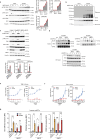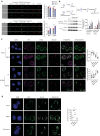Cholesterol-binding motifs in STING that control endoplasmic reticulum retention mediate anti-tumoral activity of cholesterol-lowering compounds
- PMID: 38553448
- PMCID: PMC10980718
- DOI: 10.1038/s41467-024-47046-5
Cholesterol-binding motifs in STING that control endoplasmic reticulum retention mediate anti-tumoral activity of cholesterol-lowering compounds
Abstract
The cGAS-STING pathway plays a crucial role in anti-tumoral responses by activating inflammation and reprogramming the tumour microenvironment. Upon activation, STING traffics from the endoplasmic reticulum (ER) to Golgi, allowing signalling complex assembly and induction of interferon and inflammatory cytokines. Here we report that cGAMP stimulation leads to a transient decline in ER cholesterol levels, mediated by Sterol O-Acyltransferase 1-dependent cholesterol esterification. This facilitates ER membrane curvature and STING trafficking to Golgi. Notably, we identify two cholesterol-binding motifs in STING and confirm their contribution to ER-retention of STING. Consequently, depletion of intracellular cholesterol levels enhances STING pathway activation upon cGAMP stimulation. In a preclinical tumour model, intratumorally administered cholesterol depletion therapy potentiated STING-dependent anti-tumoral responses, which, in combination with anti-PD-1 antibodies, promoted tumour remission. Collectively, we demonstrate that ER cholesterol sets a threshold for STING signalling through cholesterol-binding motifs in STING and we propose that this could be exploited for cancer immunotherapy.
© 2024. The Author(s).
Conflict of interest statement
M.R.J. is shareholder within STipe Therapeutics that develop cancer immunotherapies targeting the STING pathway. The remaining authors declare no competing interests.
Figures






References
MeSH terms
Substances
Grants and funding
- NNF20OC0062825/Novo Nordisk Fonden (Novo Nordisk Foundation)
- NNF18OC0030274; NNF20OC0063436/Novo Nordisk Fonden (Novo Nordisk Foundation)
- R238-2016-2708/Lundbeckfonden (Lundbeck Foundation)
- R149-A10193-16S-4/Kræftens Bekæmpelse (Danish Cancer Society)
- 786602/EC | EC Seventh Framework Programm | FP7 Ideas: European Research Council (FP7-IDEAS-ERC - Specific Programme: "Ideas" Implementing the Seventh Framework Programme of the European Community for Research, Technological Development and Demonstration Activities (2007 to 2013))
LinkOut - more resources
Full Text Sources
Medical
Research Materials

